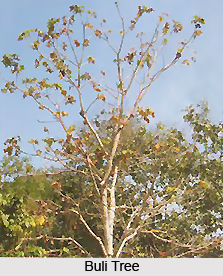 Buli is an Indian medicinal plant which is called Kada, Karai and Kagdol in Gujarati, Bhutali, Pinari and Kempudale in Kannada, Thondi, Tonti and Kithondi in Malayalam, Gudalo and Kav-ili in Oriya, Kavalam, Sigapputtanaku, Vellaip-Puttali and Tanakku in Tamil, Gular, Karrai, Gulu, Katira and Kulu in Hindi, Pandrukin Konkani, Kandol, Karai, Gwira and Pandruk in Marathi, Arjuna and Balika in Sanskrit and Ettapon-Aku, Kalvi kavili, Tabsu tanuku, Errapunikichettu and Tapasi in Telugu language. The Botanical name of Buli is Sterculia urens Roxb. This plant is found in the state of Gujarat, Rajasthan, Karnataka and various other parts of India.
Buli is an Indian medicinal plant which is called Kada, Karai and Kagdol in Gujarati, Bhutali, Pinari and Kempudale in Kannada, Thondi, Tonti and Kithondi in Malayalam, Gudalo and Kav-ili in Oriya, Kavalam, Sigapputtanaku, Vellaip-Puttali and Tanakku in Tamil, Gular, Karrai, Gulu, Katira and Kulu in Hindi, Pandrukin Konkani, Kandol, Karai, Gwira and Pandruk in Marathi, Arjuna and Balika in Sanskrit and Ettapon-Aku, Kalvi kavili, Tabsu tanuku, Errapunikichettu and Tapasi in Telugu language. The Botanical name of Buli is Sterculia urens Roxb. This plant is found in the state of Gujarat, Rajasthan, Karnataka and various other parts of India.
Buli is a medium-sized deciduous tree which is up to 15 meters tall with a short trunk and spreading branches. The bark is smooth, thin, papery, greyish-white and pale green or copperish and the young parts are more or less pubescent. The leaves of this plant are simple, clustered at the ends of the branches, 15 to 25 centimetres long and wide, palmately-sinuately 5-lobed, slightly pubescent above, softly velvety beneath, lobes entire, acuminate, base cordate and 7-nerved. The petioles are terete and are 12.5 to 23 centimetres long and velvety tomentose. Flowers of this plant are numerous, small and 0.6 to 0.9 centimetres in diameter, greenish-yellow in colour, spotted with purple, with a disagreeable fetid odour, borne in dense pyramidal terminal panicles up to 25 centimetres long, appearing before the leaves at the ends of branches. Follicles are 4 to 6, red or yellowish-brown in colour, radiating, ovoid-oblong, approximately 2.5 centimetres in diameter, coriaceous, yellow bristly pubescent with stinging hairs. The seeds are 3 to 6, oblong and black. In central Indian deciduous forests trees are leafless between the months of October and June and the flowering takes place between the months of December and February and the fruits of Buli mature from March to April.
Buli is very common in dry deciduous forests and open grasslands on shallow soils and exposed hill slopes in the sub-Himalayan hills from the Ganges eastwards, Gujarat, Rajasthan, and in central and southern India to northern Karnataka. It can also bee seen in Mizoram.
The bark of Buli yields a useful gum of commercial importance, with properties similar to those of gum tragacanth (received from Astralagus spp.: Fabaceae-Papilionoideae). It is used in medicinal and pharmaceutical preparations, like emulsions, lozenges, lotions, sprays and pastes and among the Santhalis it is used for treating throat affections. Among the tribal inhabitants of Sundargarh District in the Indian state of Orissa the gum is given with sugar-candy to get relief from dyspepsia and diarrhoea. In the Surguja District of northeastern Madhya Pradesh, the gum, soaked in water and mixed with either sugar or milk, is given orally for diarrhoea and dysentery; the gum is applied locally and the juice of the stem bark is used orally to treat piles; and the root, pounded with black pepper, is taken with water to get relief from fever. A paste of the young leaves is used externally to relieve cracked or chapped skin by the Bhils in Rajasthan state. The tender branches and leaves, when steeped in water, yield a mucilaginous extract used for the treatment of pleuro-pneumonia in cattle.



















